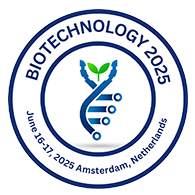Call for Abstract
Scientific Program
29th World Congress on Biotechnology, will be organized around the theme “Biotechnology and Artificial Intelligence: A Powerful Partnership”
Biotechnology 2025 is comprised of keynote and speakers sessions on latest cutting edge research designed to offer comprehensive global discussions that address current issues in Biotechnology 2025
Submit your abstract to any of the mentioned tracks.
Register now for the conference by choosing an appropriate package suitable to you.
Genomic biotechnology has revolutionized medicine, agriculture, and environmental science. This track delves into innovations such as CRISPR-Cas9, gene therapy, and genomic sequencing to combat genetic disorders, enhance crop resilience, and optimize industrial bioprocesses. Discussions will also focus on the ethical implications and regulatory frameworks of genomic interventions.
Topics:
- CRISPR and Genome Editing
- Genomic Data Analysis
- Gene Therapy Applications
- Ethical Challenges in Genomic Biotechnology
Synthetic biology integrates engineering principles with biology to design and construct novel biological systems. This session explores breakthroughs in creating synthetic pathways, improving biomanufacturing efficiency, and developing programmable biological devices for medical and industrial applications.
Topics:
- Designing Synthetic Pathways
- Biosensors for Disease Detection
- Bioengineering in Drug Development
- Industrial Biomanufacturing
This track highlights the role of biotechnology in addressing global environmental challenges. Explore innovations in bio-remediation, bioenergy production, and the development of sustainable agricultural practices to mitigate climate change and reduce pollution.
Topics:
- Bioremediation of Pollutants
- Microbial Fuel Cells
- Bio-based Plastics and Sustainability
- Biotechnology for Carbon Sequestration
Agricultural biotechnology is vital for ensuring food security and sustainability. This session discusses advancements in genetically modified crops, precision farming, and innovations in pest and disease management.
Topics:
- GMO Crops for Enhanced Nutrition
- Biopesticides and Biofertilizers
- Precision Agriculture and IoT
- Biotechnology in Livestock Improvement
Industrial biotechnology focuses on using biological systems for manufacturing processes. This track covers enzyme technologies, fermentation processes, and the role of microbes in producing biofuels, chemicals, and bioplastics.
Topics:
- Fermentation Technologies
- Enzyme Engineering for Industrial Use
- Bio-based Production of Chemicals
- Scale-Up Challenges in Industrial Biotech
This track explores the application of biotechnology in developing diagnostic tools, therapeutics, and medical devices. Emphasis will be on emerging technologies like nanobiotechnology and tissue engineering.
Topics:
- Nanobiotechnology in Medicine
- Bioprinting and Regenerative Medicine
- Advances in Biomarkers and Diagnostics
- Drug Delivery Systems
Biotechnology has transformed vaccine development and immunotherapy. Explore novel strategies for developing vaccines for infectious diseases and using immunotherapy for cancer treatment.
Topics:
- mRNA Vaccines and Beyond
- Immunotherapy for Cancer
- Adjuvant Technologies
- Challenges in Vaccine Accessibility
Biopharmaceuticals have become a cornerstone of modern medicine. This track examines the development, production, and regulatory challenges of biopharmaceuticals and biosimilars.
Topics:
- Monoclonal Antibody Therapeutics
- Regulatory Pathways for Biosimilars
- Bioprocess Optimization
- Emerging Biopharmaceutical Markets
The oceans are a vast resource for biotechnological innovation. This session focuses on marine-derived biomaterials, bioactive compounds, and their applications in medicine and industry.
Topics:
- Marine Microorganisms for Drug Discovery
- Bioactive Compounds from Algae
- Marine-Derived Enzymes for Industry
- Sustainable Aquaculture Practices
The integration of computational tools with biology has enabled deeper insights into complex systems. This track discusses computational modeling, bioinformatics, and systems biology approaches to understanding biological processes.
Topics:
- Machine Learning in Biotechnology
- Computational Drug Design
- Systems Biology in Pathway Analysis
- Network Models of Disease
Microbes play a critical role in biotechnology. This session explores their use in producing biofuels, enzymes, and pharmaceuticals, as well as their application in waste management.
Topics:
- Engineering Microbial Strains
- Microbes in Wastewater Treatment
- Metabolic Pathway Optimization
- Microbial Bioproducts
Biotechnology holds immense promise in addressing global health challenges, including infectious diseases and non-communicable diseases. Discussions will center on low-cost diagnostics, therapeutics, and innovations tailored for underserved populations.
Topics:
- Biotechnology for Neglected Tropical Diseases
- Low-Cost Diagnostics for Developing Nations
- Gene Editing for Global Health Solutions
- Biotech Solutions for Epidemics
Regenerative medicine offers hope for treating degenerative diseases. This track focuses on stem cell research, tissue engineering, and the challenges of translating these technologies into therapies.
Topics:
- Stem Cell Therapy Innovations
- Tissue Engineering Advances
- Ethical Considerations in Regenerative Medicine
- Commercializing Regenerative Therapies
Scaling up biotechnological processes from lab to industry presents unique challenges. This session addresses strategies for bioprocess optimization, scalability, and regulatory compliance.
Topics:
- Bioreactor Design and Optimization
- Downstream Processing Innovations
- Scaling Up Fermentation Processes
- Quality Assurance in Biomanufacturing
This track provides a forward-looking perspective on biotechnology's potential. Emerging fields like bioinformatics, personalized medicine, and synthetic biology will be explored.
Topics:
- Personalized Medicine and Precision Biotech
- Advances in Bioinformatics Tools
- Synthetic Biology's Future Impact
- Biotechnology for Space Exploration

